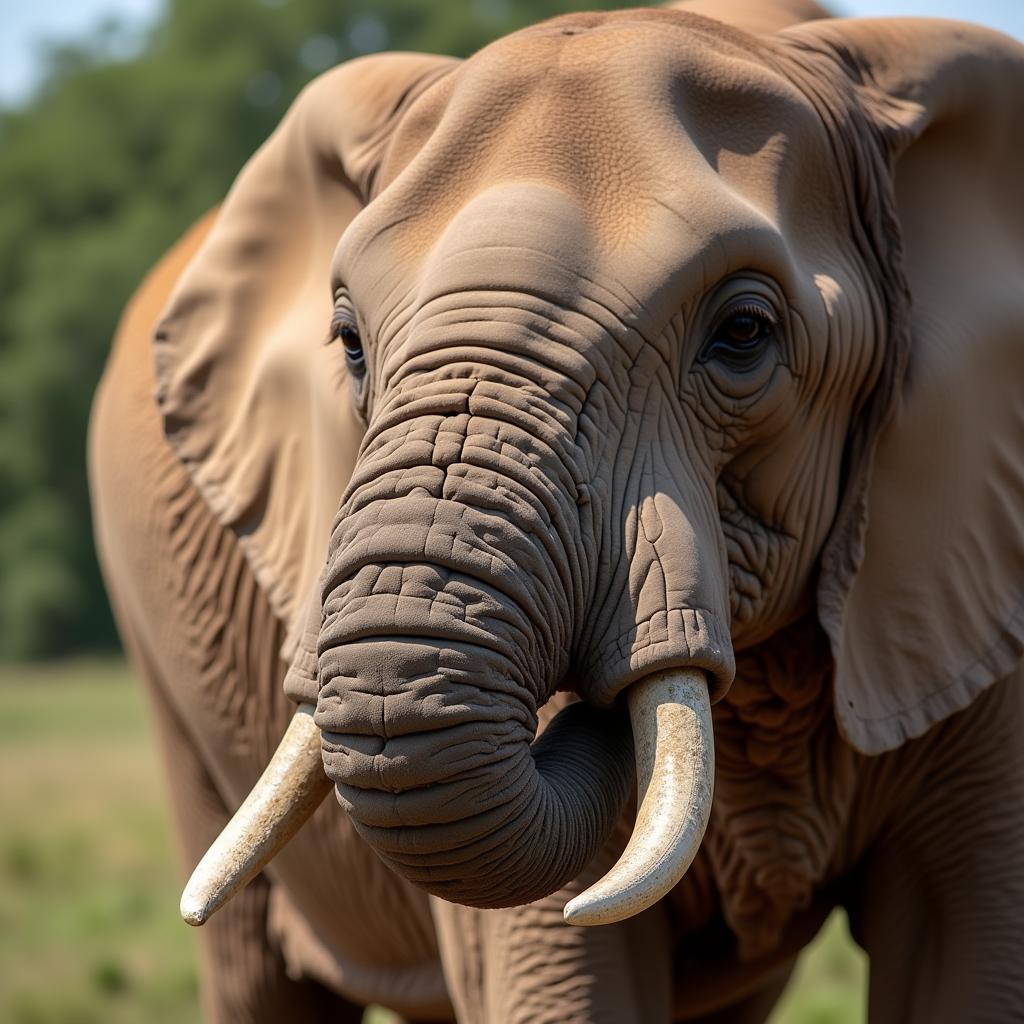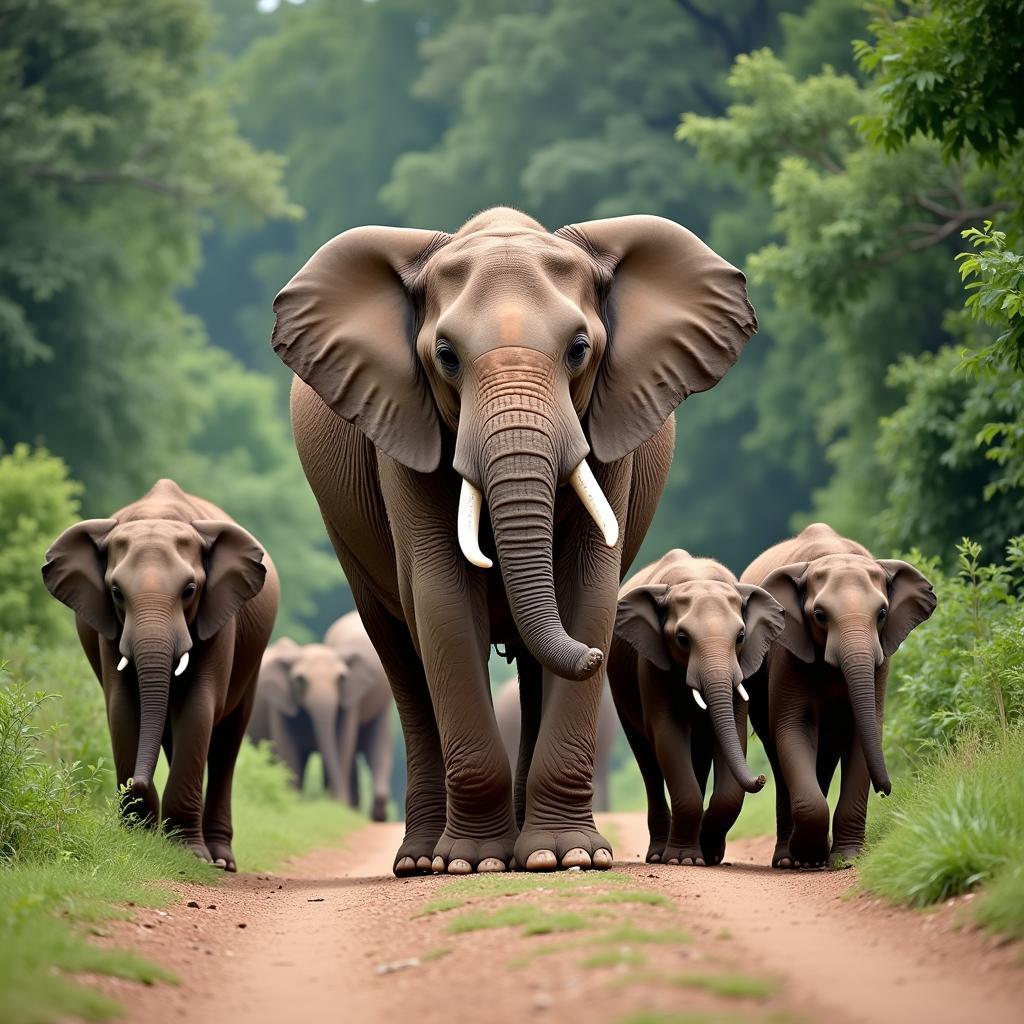African Bush Elephant vs Asian Elephant: Unveiling the Giants
African bush elephants and Asian elephants are iconic symbols of power and wisdom. They captivate our imagination and remind us of the incredible biodiversity gracing our planet. But while they share the title of “elephant,” these magnificent creatures have distinct differences that set them apart. Let’s delve into the fascinating world of these gentle giants and uncover the unique characteristics of the African Bush Elephant Vs Asian Elephant.
Size and Stature: A Tale of Two Giants
One of the most noticeable differences between African bush elephants and Asian elephants lies in their size. African bush elephants reign supreme as the largest land mammals on Earth. Males can reach a towering shoulder height of up to 3.3 meters (11 feet) and weigh up to a staggering 6,000 kilograms (13,200 pounds). Females are slightly smaller, with an average height of 2.5 meters (8 feet) and a weight of around 3,000 kilograms (6,600 pounds).
On the other hand, Asian elephants are comparatively smaller. Males typically grow up to 3 meters (10 feet) tall and weigh up to 5,400 kilograms (12,000 pounds). Females, like their African counterparts, are smaller, reaching heights of 2.5 meters (8 feet) and weighing around 2,700 kilograms (6,000 pounds).
A Closer Look: Distinguishing Features
Beyond size, several physical characteristics distinguish African bush elephants from Asian elephants.
-
Ears: African bush elephants boast massive, fan-shaped ears that cover their shoulders. These ears play a crucial role in thermoregulation, helping to dissipate heat and keep the elephants cool in the African savanna. Asian elephants have smaller, more rounded ears.
-
Tusks: Both male and female African bush elephants possess tusks, elongated incisor teeth that continue to grow throughout their lives. In contrast, only some male Asian elephants have tusks, and females rarely develop them.
-
Head Shape: African bush elephants have a concave head shape, while Asian elephants have a convex or rounded head shape.
-
Back Shape: The back of an African bush elephant slopes downward from its shoulders, while the back of an Asian elephant is more level or even arches slightly upward.
 African Bush Elephant Using Its Trunk
African Bush Elephant Using Its Trunk
Trunk Tales: A Remarkable Adaptation
Both African bush elephants and Asian elephants possess a trunk, a fusion of the nose and upper lip that serves as a versatile tool. This incredible appendage is essential for various functions, including:
-
Breathing: The trunk serves as the elephant’s nasal passage, allowing it to breathe.
-
Drinking: Elephants use their trunks to suck up water and then spray it into their mouths.
-
Communication: Trumpeting sounds produced through the trunk are essential for communication, conveying a range of emotions from excitement to distress.
-
Feeding: Elephants use their trunks to grasp vegetation and bring it to their mouths.
While both species share this remarkable adaptation, a subtle difference lies in the tip of the trunk. African bush elephants have two finger-like projections at the tip, which provide enhanced dexterity for grasping small objects. In contrast, Asian elephants have only one projection, making it slightly more challenging to manipulate small items.
Habitat and Distribution: A Continent Apart
As their names suggest, African bush elephants and Asian elephants are native to different continents.
African bush elephants roam the savannas, forests, and deserts of sub-Saharan Africa. They are widely distributed across the continent, with significant populations in countries such as Botswana, Tanzania, and Zimbabwe.
Asian elephants, on the other hand, are found in fragmented populations across South and Southeast Asia. They inhabit grasslands, forests, and swamps in countries like India, Sri Lanka, and Thailand.
Social Structure: Matriarchal Herds
Both African bush elephants and Asian elephants exhibit complex social structures centered around matriarchal herds.
Female elephants and their young offspring form the core of these herds, led by the oldest and most experienced female, known as the matriarch. She guides the herd in search of food, water, and suitable breeding grounds, passing down her knowledge and experience to subsequent generations.
Adult male elephants typically live solitary lives or form small bachelor groups. They join the female herds primarily during the mating season.
Conservation Status: Facing Threats
Both African bush elephants and Asian elephants face numerous threats to their survival, primarily due to human activities.
-
Habitat Loss: Deforestation, agriculture, and human settlements are encroaching upon the elephants’ natural habitats, leading to habitat loss and fragmentation.
-
Poaching: The illegal ivory trade poses a grave threat to both species, particularly African elephants, which are targeted for their larger tusks.
-
Human-Elephant Conflict: As human populations expand and overlap with elephant ranges, conflicts over resources, such as crops and water, are becoming increasingly common.
The International Union for Conservation of Nature (IUCN) classifies African bush elephants as “Endangered” and Asian elephants as “Endangered” on their Red List of Threatened Species.
 Asian Elephant Family Group
Asian Elephant Family Group
Conclusion: Celebrating the Giants
African bush elephants and Asian elephants are magnificent creatures that play vital roles in their respective ecosystems. Understanding their unique characteristics, habitats, and the threats they face is crucial for their conservation. By appreciating their differences and working together to protect them, we can ensure that these gentle giants continue to roam the Earth for generations to come.
FAQs:
1. Which elephant is bigger: African or Asian?
African bush elephants are the largest of the two species.
2. Do all elephants have tusks?
No, only some male Asian elephants have tusks, while both male and female African bush elephants typically possess tusks.
3. What is the main threat to elephants?
Habitat loss, poaching, and human-elephant conflict are the primary threats to both African bush elephants and Asian elephants.
4. How long do elephants live?
Elephants have a lifespan similar to humans, typically living for 60 to 70 years in the wild.
5. Where can I see elephants in the wild?
You can see African bush elephants in various countries across sub-Saharan Africa, while Asian elephants are found in fragmented populations in South and Southeast Asia.
You might also like:
Need help planning your African adventure to witness these magnificent creatures? Contact us at +255768904061, email us at kaka.mag@gmail.com, or visit us in Mbarali DC Mawindi, Kangaga, Tanzania. Our dedicated team is available 24/7 to assist you!

